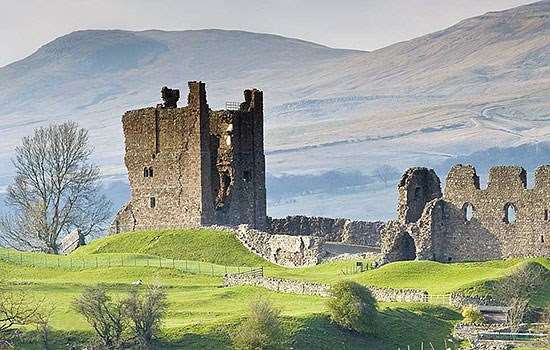History of Berkhamsted Castle
Berkhamsted Castle was first built as a timber motte-and-bailey castle in the late 11th century. One of the most important early Norman castles, it controlled the northern approach to London, 30 miles away. Kept in royal hands, it was occupied by key figures of the Middle Ages, such as Thomas Becket, Richard, Earl of Cornwall, and the Black Prince. Much of its stone was plundered during the 16th century.

Origins of the Castle
William the Conqueror received the submission of the English at Berkhamsted Castle after the Battle of Hastings. His half-brother, Robert of Mortain, built a timber castle there in about 1070. It was in the classic Norman motte-and-bailey form, with a defensive conical mound and oval bailey below.
The castle stayed in royal hands, and in 1155 Thomas Becket was granted the honour of Berkhamsted by King Henry II. As chancellor, Becket was the king’s right hand man and enjoyed great favour. He rebuilt the castle to befit his new status and house his large staff. Becket's buildings probably included the huge stone curtain wall.
Later in 1164, during his quarrel with the king, Becket was accused of embezzlement. He was disgraced and deprived of the honour of Berkhamsted.
Defending the Castle
Berkhamsted was designed as a fortress, with impressive earthwork defences, high motte and stone curtain wall. The water-filled ditches prevented tunnelling under the wall, and the motte could protect the bailey as well as defend attacks from the north.
In 1216, the castle’s defences were put to the test. Prince Louis of France had invaded England at the invitation of the English barons, who were opposed to King John. When John died in October 1216, his nine-year-old son was crowned King Henry III. Louis had to act quickly.
Louis besieged the castle for two weeks, battering it with huge stones flung from siege weapons. The earthwork buttresses by the outer ditch were probably platforms to support them, although it is still unclear which side built them. The castle surrendered finally on the orders of the king.
A Palatial Home
Berkhamsted Castle was granted to Richard, Earl of Cornwall, in 1225 by his brother, King Henry III. Richard was believed to be the richest man in England and was also a skilful diplomat. He was often needed at the royal court in London.
Richard made Berkhamsted the administrative centre of the earldom of Cornwall. Bailiffs from his numerous estates brought their accounts there. He repaired and refurbished the castle and enlarged the western tower to create a luxurious palace complex. Parts of the palace, believed to be the chapel and possibly the undercroft of the Great Painted Chamber, remain.
Richard’s son Edmund was born at the castle and two of his wives died there. He himself died at Berkhamsted in 1272.
The Black Prince
A century later Edward, the Black Prince (1330–71), son and heir of Edward III, was given the castle as Duke of Cornwall.
Berkhamsted was a favourite residence of the Black Prince, and he repaired the castle buildings and ordered a new timber palisade around the park to keep the deer from escaping. He married Joan, ‘the Fair Maid of Kent’, in 1361 and the couple spent their first Christmas at the castle.
Later History
The castle later passed to five queens in succession, ending with Elizabeth I. It was probably not occupied after 1495, however. When Elizabeth I granted a lease of the manor to Sir Edward Carey in 1580, he built a new house to the west – Berkhamsted Place – which is now almost totally demolished, while the castle itself gradually fell into ruin.
Further Reading
Remfry, PM, Berkhamsted Castle, 1066–1495 (Malvern, 1995)


